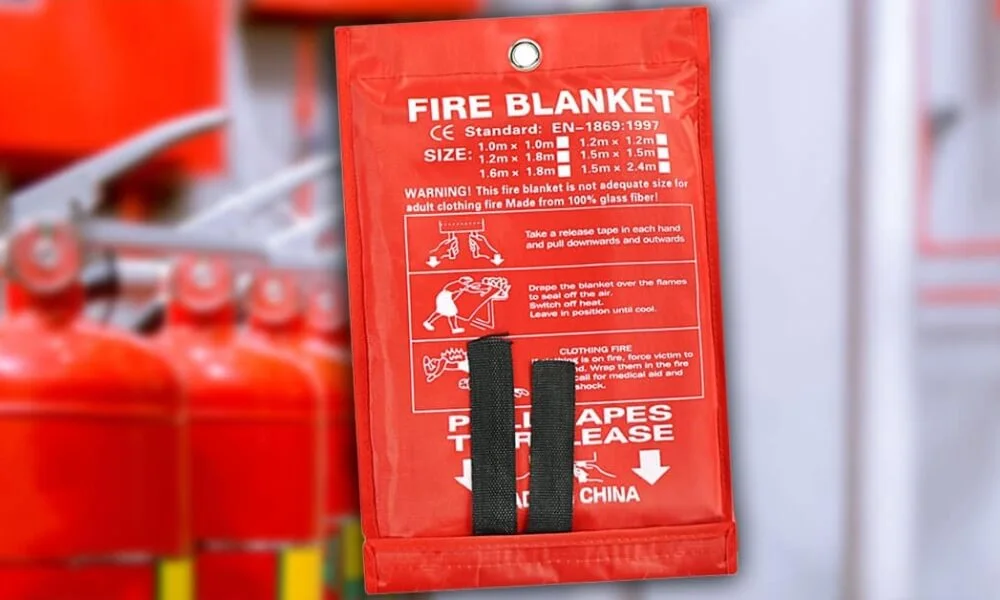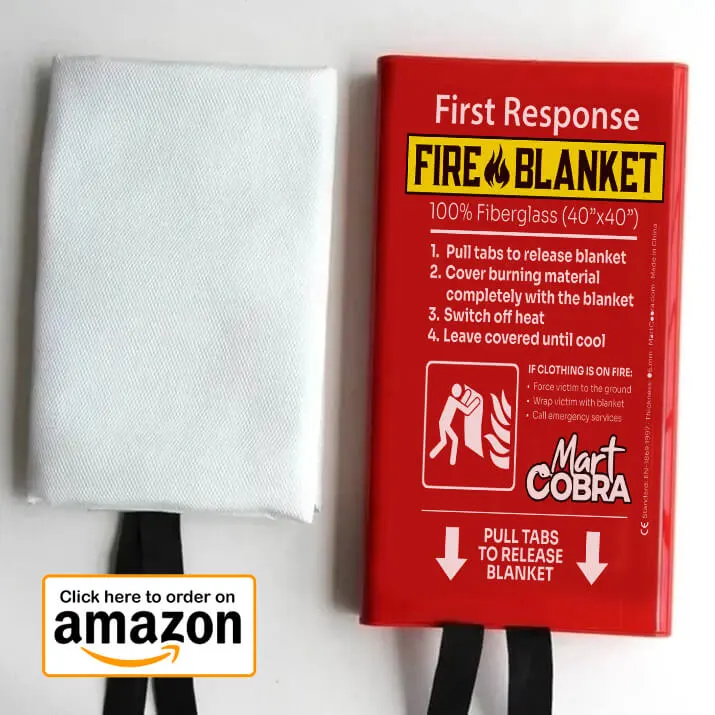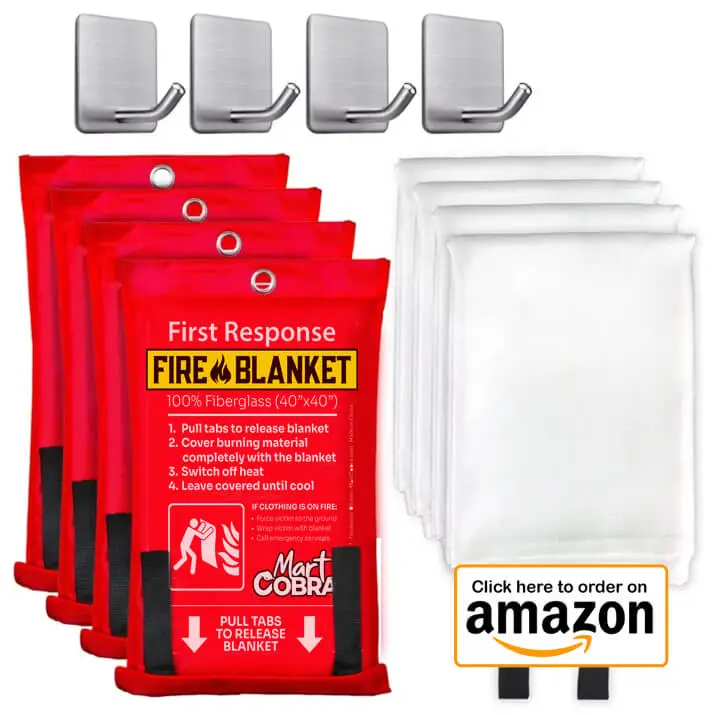Fires can strike unexpectedly, whether in your kitchen, workshop, or during a cozy campfire. A fire blanket, though often overlooked, is a remarkably simple yet effective tool for safeguarding yourself and your space.
This blog dives into everything you need to know about fire blankets – what they are, how they work, the varieties available, and their wise usage in various scenarios. Get ready to enhance your fire safety knowledge and learn how a fire blanket can be your powerful ally in the face of those unpredictable flames.
What is a Fire Blanket?
A fire blanket is a specially designed safety device used to smother small, starting fires. It’s made of fire-retardant materials like fiberglass or Kevlar, woven into a sheet. When a fire breaks out, the fire blanket is placed directly over the flames, cutting off the oxygen supply and suffocating the fire. Fire blankets are particularly useful for kitchen fires involving grease or oil, and can also be used to extinguish someone’s clothing if it accidentally catches fire.
Fire Blanket Material Composition
Fire blankets achieve their life-saving function through the use of specialized materials chosen for their fire-retardant properties:
- Fiberglass: The most common material in fire blankets, fiberglass offers a balance of fire resistance, flexibility, and cost-effectiveness for domestic and general use. It can withstand high temperatures and provides suitable heat insulation.
- Kevlar: Renowned for its strength and abrasion resistance, Kevlar is used in industrial settings where durability and enhanced fire protection are required.
- Wool: A naturally flame-retardant fiber, wool may be treated with additional fire-resistant chemicals. It offers denser construction and is often found in laboratory and industrial applications.
Coatings and Treatments
Fire blanket materials often receive further enhancements:
- Silicone: Improves water resistance and pliability for easier emergency use.
- Vermiculite: Adds heat insulation and protection from molten substances.
- Flame Retardant Chemicals: Applied to materials like wool to boost fire resistance.
Material Selection Considerations
Optimal fire blanket material depends on the intended use:
- Domestic Kitchens: Fiberglass often provides adequate protection.
- Laboratory and Industrial Settings: Wool, Kevlar, or specialty materials address more intense hazards and greater heat exposure.
- Electric Vehicle Fires: Materials like silica are being explored to combat the unique challenges of lithium-ion battery fires.
Advantages of Utilizing Emergency Fire Blankets
- Ease of Use: Fire blankets offer a highly intuitive method of fire suppression. Their straightforward deployment eliminates the need for complex operation procedures, ensuring rapid action during critical moments.
- Enhanced Safety: By smothering flames, fire blankets minimize the risk of injury or exposure to potentially hazardous extinguishing agents. This makes them particularly suitable for use by individuals without specialized training.
- Wide-Ranging Applications: Fire blankets demonstrate efficacy against several fire classes, including:
- Class F: Combustible cooking media (fats, oils)
- Class B: Flammable liquids
- Class C: Energized electrical fires (after power source is disconnected)
- Person-Centric Use: Can be applied to extinguish clothing fires in conjunction with the “stop, drop, and roll” technique.
- Cost-Efficiency: Fire blankets represent a budget-conscious fire safety solution. Their potential reusability (contingent on fire severity) further contributes to their cost-effectiveness.
- Proactive Fire Management: The immediate accessibility of fire blankets facilitates the containment of nascent fires. This can prevent escalation, providing valuable time for evacuation or the deployment of additional fire suppression equipment.
Essential Notes:
- Fire blankets are exclusively intended for the management of small, incipient fires.
- Familiarization with the product’s instructions is paramount for proper utilization in emergency scenarios.
- Even when a fire appears extinguished, contacting emergency services remains a crucial safety protocol.
Fire Blanket
Fire blankets are crucial safety tools, and having one readily available could be lifesaving in emergency situations.
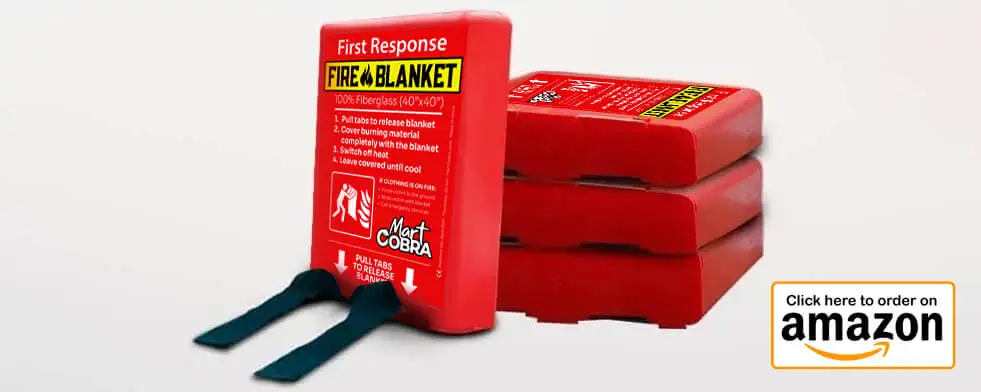
How Do Fire Blankets Work?
Fire blankets achieve their fire-suppressing function by disrupting a core principle of combustion: the Fire Triangle. This model comprises three essential components:
- Fuel Source: Any combustible material, such as flammable liquids, cooking oils, fabrics, or solids.
- Heat: The energy required for ignition and sustained combustion.
- Oxygen: The atmospheric component that supports the chemical reaction of burning.
Fire Blanket Functionality
- Oxygen Deprivation: Deploying a fire blanket over a fire creates a physical barrier that effectively occludes the flow of oxygen to the combustion zone. This smothering action disrupts the oxidation process essential for continued burning.
- Thermal Reduction: The fire-retardant materials used in the blanket’s construction also serve to absorb and dissipate heat. This lowers the overall temperature of the fire, reducing the likelihood of reignition.
Effectiveness
By directly interrupting a key element of the Fire Triangle, fire blankets rapidly suppress small, localized fires. This affords a critical window of opportunity to evacuate safely or utilize additional firefighting resources if needed.
Important Considerations:
- Fire blankets are an effective tool for extinguishing incipient (early-stage) fires. They are not designed for large-scale or rapidly spreading fire events.
- Prior familiarization with the fire blanket’s instructions for use is crucial for effective and safe deployment in an emergency.
- Professional fire services should be alerted even when a fire has been seemingly extinguished with a blanket. Embers and heat sources may present a continued risk.
Types of Fire Blankets: Which One is Best?
There are various types of fire blankets available, each designed for specific situations. The most common material used is fiberglass, known for its fire-resistant properties. When purchasing a fire blanket, it’s essential to review the manufacturer’s specifications to ensure it’s suitable for your needs. Here’s a detailed look at the types of fire blankets and their specific uses:
1. Fiberglass Fire Blankets
- Material: Predominantly made from woven fiberglass threads.
- Properties: Fiberglass is inherently fire-resistant, making it an ideal material for fire blankets.
- Usage: Suitable for general household and industrial fires, including kitchen fires and electrical fires.
- Advantages: Lightweight, easy to store, and offers a high degree of protection against burns when used correctly.
2. Wool Fire Blankets with Flame-retardant Fluid
- Material: Comprises wool that’s been soaked in a flame-retardant fluid.
- Properties: The fluid enhances the fire-resistant properties of the wool.
- Usage: Often found in laboratories or settings where chemical fires are a potential risk.
- Advantages: It can be draped over a person to protect against flames and heat.
3. Fire-resistant Cotton Blankets
- Material: Made from cotton treated with fire-resistant chemicals.
- Properties: While not as effective as fiberglass, they offer a degree of fire protection.
- Usage: Suitable for situations where direct flame contact is minimal, such as escaping a fire.
- Advantages: More comfortable against the skin and can be used to shield from heat.
4. Industrial Fire Blankets
- Material: Often made from a combination of materials, including fiberglass and synthetic compounds.
- Properties: Designed to withstand higher temperatures and more severe fire hazards.
- Usage: Used in industrial settings where the risk of large or high-temperature fires exists.
- Advantages: Offers protection in intense fire situations, often larger in size to cover machinery or workstations.
Choosing the Best Fire Blanket
When deciding on the best fire blanket for your needs, consider the following:
- Intended Use: Determine the primary use, whether it’s for a kitchen, laboratory, industrial setting, or general household safety.
- Size Requirements: Depending on the potential fire source, choose an appropriately sized blanket.
- Material Comfort: If the blanket might be used to wrap around a person, consider the comfort of the material against the skin.
- Manufacturer’s Specifications: Always review the manufacturer’s guidelines and certifications to ensure the blanket meets safety standards and is suitable for the intended use.
While fiberglass fire blankets are among the most common and versatile, the best fire blanket depends on individual needs and specific situations. Always prioritize safety and ensure regular checks and maintenance of the blanket to guarantee its effectiveness when needed.
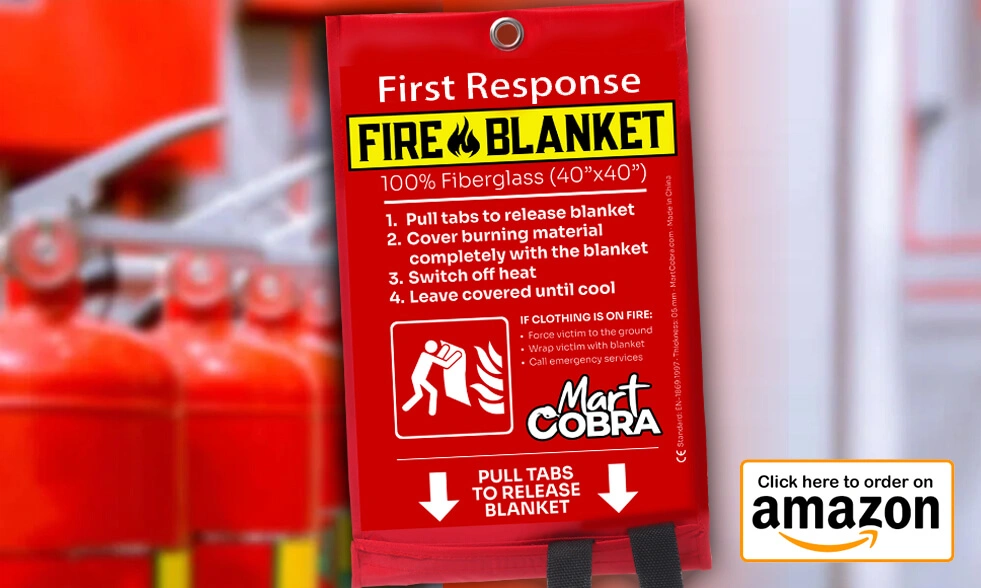
Emergency Fire Blanket Uses: Beyond the Kitchen
While the kitchen, with its open flames and hot oils, is a common site for small fires, fire blankets have a range of applications in various settings:
Laboratories:
- Small Chemical Fires: Fire blankets can be a first line of defense in smothering accidental fires involving flammable chemicals, especially when using water might exacerbate the situation.
- Equipment Malfunctions: Equipment sparking or overheating can be quickly contained with a fire blanket, preventing fires from spreading.
Industrial Settings:
- Welding & Metalworking: Sparks and splatter from welding or other metalworking processes can easily ignite nearby materials. A fire blanket provides immediate suppression, minimizing fire risk.
- Machinery Malfunctions: Electrical failures or overheating in machinery are potential fire hazards. A fire blanket offers a rapid initial response before a fire can escalate.
Vehicles:
- Engine Fires: In the event of car engine fires, fire blankets can help contain flames, offering time for people to evacuate and for fire services to arrive.
- Fuel Spills: Small spills of flammable liquids can be quickly covered by a fire blanket to prevent them from igniting.
Outdoor Settings:
- Campfires & Grills: Out-of-control campfires or accidental grill flare-ups can be managed with large fire blankets, preventing them from spreading to surrounding vegetation.
Other Uses
- Clothing Fires: If a person’s clothes catch fire, wrapping them in a fire blanket helps smother flames (ideally in conjunction with the “stop, drop, and roll” technique).
Important Considerations
- Material & Size: Industrial scenarios might require heavier-duty fire blankets than those for the kitchen. Size should always be sufficient to cover the potential hazard.
- Accessibility: Fire blankets are most effective when they are readily accessible in emergencies.
- Training: While fire blankets are simple to use, understanding their limits and knowing when to call the fire department is crucial.
Limitations and Risks of Fire Blankets
While fire blankets are a versatile tool in fire safety, they come with their own set of limitations:
Limitations:
- Small Fires Only: Fire blankets are primarily designed to contain small, confined fires in their early stages. They are not suitable for battling large, out-of-control blazes.
- Proximity: Effective use of a fire blanket requires you to get quite close to the fire, increasing the potential for burns or smoke inhalation.
- Unfamiliar Materials: Fire blankets are less effective at smothering certain fires, such as those involving flammable metals, reactive chemicals, or deep oil fryers. These fires may require specialized extinguishing methods.
- Deployment Issues: Incorrect deployment, such as dropping the blanket instead of placing it carefully, can spread the fire or allow oxygen inflow.
Risks:
- False Sense of Security: Overreliance on fire blankets can lull users into underestimating the dangers of larger fires. Evacuation and calling emergency services are always crucial.
- Potential for Burns: Improper handling of the fire blanket, especially if it has been heated due to fire exposure, can result in burns.
- Smoke Inhalation: While attempting to extinguish a fire, smoke inhalation remains a hazard. Care must be taken to minimize potential exposure.
- Post-Use Risk: Even after a fire seems extinguished, the contained area can still be extremely hot. It’s essential to contact the fire department for assessment to prevent reignition.
Important Takeaways:
- Fire blankets are valuable tools for initial fire suppression, but their limitations must be recognized.
- Proper training in fire blanket usage is vital to ensure effective and safe deployment.
- Fire blankets should be integrated into a comprehensive fire safety plan that includes evacuation procedures and immediately contacting emergency services.
Steps to Use a Fire Blanket Correctly
- Pull the fire blanket from its storage pouch.
- Hold the blanket by its top corners, ensuring it covers your hands.
- Place the blanket over the fire, smothering it completely.
- Turn off any heat sources, if possible.
- Leave the blanket in place until the area has cooled.
Using a fire blanket effectively requires a series of steps to ensure both the user’s safety and the complete extinguishing of the fire. Here’s a detailed breakdown of each step:
1. Pull the Fire Blanket from its Storage Pouch:
- Why: Fire blankets are typically stored in a quick-release pouch for rapid deployment during emergencies.
- How: Approach the storage pouch and swiftly pull the two tabs or straps. This action should release the folded blanket, making it ready for use.
2. Hold the Blanket by its Top Corners:
- Why: Holding the blanket by its top corners ensures maximum coverage and control when approaching the fire. Additionally, it provides a shield for your hands, protecting them from the flames and heat.
- How: Grasp the two top corners or edges of the blanket firmly. Make sure the rest of the blanket hangs down, creating a protective barrier between you and the fire.
3. Place the Blanket Over the Fire:
- Why: The primary function of the fire blanket is to smother the fire, depriving it of oxygen, which is essential for combustion.
- How: Approach the fire cautiously and lay the blanket gently over the flames, ensuring the fire is entirely covered. The blanket should touch the surface around the fire, creating a seal that cuts off the oxygen supply to the flames.
4. Turn Off Any Heat Sources, If Possible:
- Why: Eliminating the heat source ensures that there’s no chance of reignition once the fire is smothered.
- How: If the fire is due to a stove, oven, or any electrical appliance, turn off the appliance or disconnect its power source. If it’s not safe to do so immediately, wait until the fire is under control.
5. Leave the Blanket in Place Until the Area Has Cooled:
- Why: Removing the blanket prematurely can reintroduce oxygen, potentially reigniting the fire. The retained heat might also cause burns or reignite flammable materials.
- How: After placing the blanket over the fire, do not attempt to remove it immediately. Let it sit for a considerable time, typically 30 minutes to an hour, to ensure the area underneath has cooled down sufficiently.
In conclusion, while using a fire blanket is straightforward, understanding each step’s significance and executing it with care is crucial. Regular training or drills can help familiarize users with the process, ensuring effective use during real emergencies.
Maintenance and Care: Keeping Your Fire Blanket in Top Shape
A fire blanket is a crucial safety tool, and like all safety equipment, its effectiveness is contingent upon proper maintenance and care. Here’s a comprehensive guide to ensure your fire blanket remains in optimal condition:
1. Regular Inspection:
- Why: Over time, fire blankets can degrade, especially if they’ve been stored improperly or exposed to harsh conditions.
- How: At least once a year (or more frequently in industrial settings), take the blanket out of its pouch and inspect it for any signs of wear, tear, or damage. Look for holes, frayed edges, or any discoloration.
2. Proper Storage:
- Why: Storing the fire blanket correctly ensures its longevity and quick accessibility during emergencies.
- How: Always store the fire blanket in its designated pouch or container. The storage location should be easily accessible, free from moisture, and away from direct sunlight or extreme temperatures.
3. Clean After Use:
- Why: If you’ve used the fire blanket to smother a fire, it might have residues like soot, grease, or other contaminants.
- How: Gently clean the blanket with mild soap and water. Avoid using harsh chemicals or scrubbing vigorously, as this might damage the blanket’s fire-resistant properties. After cleaning, ensure the blanket is thoroughly dried before repacking.
4. Repacking:
- Why: After inspection or cleaning, it’s essential to repack the blanket correctly to ensure rapid deployment during emergencies.
- How: Follow the manufacturer’s guidelines for folding and repacking. Typically, the blanket should be folded in a way that allows for quick and easy release when the pouch or container is opened.
5. Replacement Considerations:
- Why: Even with the best care, fire blankets have a lifespan. If a blanket shows signs of damage or has been used to extinguish a significant fire, it might be time for a replacement.
- How: Consult the manufacturer’s guidelines. Some fire blankets are designed for single use, while others might be reusable if they’re in good condition. If in doubt, it’s safer to replace the blanket to ensure maximum protection.
6. Training and Familiarity:
- Why: Regularly practicing how to use a fire blanket ensures that you can deploy it effectively during emergencies.
- How: Conduct periodic drills or training sessions. Familiarize yourself with the blanket’s deployment mechanism, and practice the steps to use it correctly.
7. Manufacturer’s Guidelines:
- Why: Different fire blankets might have specific care and maintenance requirements based on their material and design.
- How: Always refer to the manufacturer’s instructions for care, cleaning, storage, and replacement criteria. Adhering to these guidelines ensures the blanket’s effectiveness and longevity.
Legal and Safety Standards: What Does the Law Say?
Various legal standards and regulations are in place to ensure fire blankets’ safety and effectiveness. While these can vary by country, the goal is to guarantee that fire blankets can perform adequately in a fire emergency. Additionally, certain certifications can assure a product’s quality and safety.
Here’s an overview of some general standards to consider:
Standards And Regulations
- USA: In the United States, fire blankets and fire safety equipment are regulated by various bodies, including the National Fire Protection Association (NFPA) and the Occupational Safety and Health Administration (OSHA).
- EU: In the European Union, fire blankets should carry a CE mark, indicating they comply with EU safety, health, and environmental requirements. They should also comply with BS EN 1869:1997, the British Standard specifying fire blankets’ performance, design, and testing requirements.
- Australia: In Australia, fire blankets should comply with the Australian Standard AS/NZS 3504. This standard ensures the fire blanket is fire-resistant and effective in smothering small fires.
Certifications To Look For When Purchasing
- BS EN 1869:1997 Compliance: This is the British Standard for fire blankets for use in the home and in commercial kitchens. Compliance with this standard ensures the blanket has been tested and verified for fire resistance.
- UL (Underwriters Laboratories) Listed: UL is a globally recognized safety certification company. A UL-Listed fire blanket indicates that it has been tested and meets specific requirements based on UL’s safety standards.
- CE Marking: In Europe, the CE mark signifies that a product complies with health, safety, and environmental protection standards for products sold within the European Economic Area (EEA).
When purchasing a fire blanket, looking for products that meet the appropriate legal and safety standards is crucial. In addition, always buy from reputable manufacturers and suppliers to ensure the quality and reliability of the fire safety equipment.
Fire Blanket vs. Fire Extinguisher: Which Should You Choose?
Both fire blankets and fire extinguishers are essential tools in fire safety, each with its unique advantages and applications. Understanding the differences between the two can help you make an informed decision about which is best suited for your needs. Here’s a detailed comparison:
1. Basic Functionality:
- Fire Blanket: A fire blanket is designed to smother small fires by depriving them of oxygen. It’s a sheet made of fire-resistant material, typically fiberglass, that can be draped over a fire.
- Fire Extinguisher: A fire extinguisher releases a substance (often a foam, powder, or gas) to suppress and extinguish fires. The substance works by cooling the fire, depriving it of oxygen, or interrupting the chemical reaction causing the fire.
2. Suitable Applications:
- Fire Blanket:
- Ideal for small fires, especially kitchen fires caused by grease or oil.
- Useful for fires involving electrical appliances where using water or certain extinguishing agents might be dangerous.
- Fire Extinguisher:
- Designed for larger fires or fires that have spread over a bigger area.
- Different types of extinguishers (e.g., water, CO2, foam) are suitable for various fire classes, from wood and paper fires to electrical and metal fires.
3. Ease of Use:
- Fire Blanket: Generally straightforward to use, especially for individuals unfamiliar with fire safety equipment. It requires draping the blanket over the fire.
- Fire Extinguisher: Requires more knowledge to operate correctly. Users need to remember the PASS technique: Pull the pin, Aim the nozzle, Squeeze the handle, and Sweep from side to side.
4. Maintenance and Lifespan:
- Fire Blanket: Low maintenance. Requires periodic checks for damages. Some are designed for single use, while others can be reused if undamaged.
- Fire Extinguisher: Requires regular checks to ensure it’s charged and functional. Over time, it might need refilling or servicing. Typically has a defined lifespan after which it should be replaced.
5. Storage and Accessibility:
- Fire Blanket: Stored in a quick-release pouch, making it easily accessible. It’s compact and can be conveniently placed in kitchens, labs, or workshops.
- Fire Extinguisher: Bulkier and requires mounting on walls or storing in designated locations. It’s essential to have clear signage indicating its position.
6. Safety Concerns:
- Fire Blanket: Safe for most small fires but might not be effective for larger fires or specific fire types.
- Fire Extinguisher: Using the wrong type of extinguisher for a particular fire can be dangerous. For example, using a water extinguisher on an electrical fire can lead to electrocution.
In Summary:
- Fire blankets are essential safety devices made from flame-retardant materials.
- They work by smothering fires, cutting off their oxygen supply.
- Suitable for various fires, including grease and electrical fires.
- Always review the manufacturer’s guidelines before use.
- Regular maintenance and care are crucial for the longevity of your fire blanket.
Stay safe and always prioritize fire safety in every situation.

